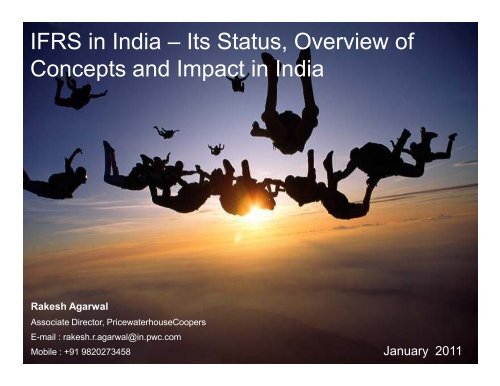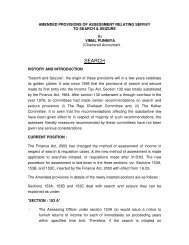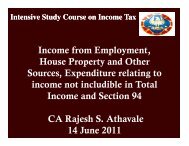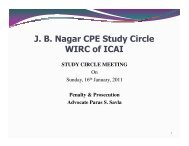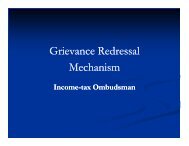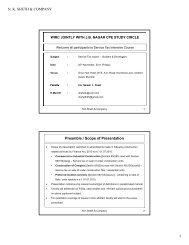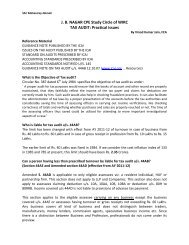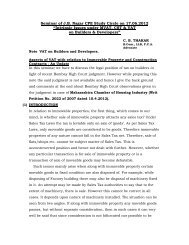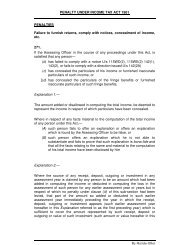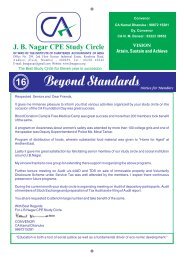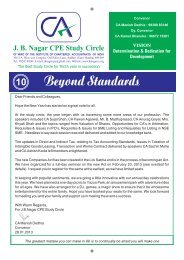IFRS in India - jb nagar cpe study circle of wirc of icai
IFRS in India - jb nagar cpe study circle of wirc of icai
IFRS in India - jb nagar cpe study circle of wirc of icai
- No tags were found...
You also want an ePaper? Increase the reach of your titles
YUMPU automatically turns print PDFs into web optimized ePapers that Google loves.
Transition<strong>in</strong>g to <strong>IFRS</strong><strong>IFRS</strong> across the worldTop 10 Global Capital MarketsUSJapanUKFranceCanadaGermanyHong KongSpa<strong>in</strong>SwitzerlandAustraliaConverg<strong>in</strong>g to <strong>IFRS</strong>Converg<strong>in</strong>g to <strong>IFRS</strong><strong>IFRS</strong><strong>IFRS</strong>Converg<strong>in</strong>g to <strong>IFRS</strong><strong>IFRS</strong><strong>IFRS</strong><strong>IFRS</strong><strong>IFRS</strong> or US GAAP<strong>IFRS</strong>Rakesh AgarwalSlide 3
IASC Constitution – The Current International F<strong>in</strong>ancialReport<strong>in</strong>g StructureSlide 4
The Preface and The FrameworkPreface to <strong>IFRS</strong>1. Objectives• A s<strong>in</strong>gle set <strong>of</strong> high quality, enforceable global account<strong>in</strong>g standards• Work with various national standard Setters for convergence2. Scope and Authority <strong>of</strong> <strong>IFRS</strong>• Designed for pr<strong>of</strong>it oriented enterprises• General purpose f<strong>in</strong>ancial statements• Bold and pla<strong>in</strong> type, have equal authority3. Due Process4. English LanguageFramework for Preparation and Presentation <strong>of</strong> F<strong>in</strong>ancial Statements1. Objectives <strong>of</strong> F<strong>in</strong>ancial Statements; <strong>in</strong>cludes cash flows2. Underly<strong>in</strong>g assumption3. Qualitative characteristics <strong>of</strong> f<strong>in</strong>ancial statementsRakesh Agarwal4. Elements <strong>of</strong> f<strong>in</strong>ancial statements, recognition and measurementSlide 5
The different levels <strong>of</strong> <strong>IFRS</strong>STANDARDSInternational F<strong>in</strong>ancial Report<strong>in</strong>gStandards (<strong>IFRS</strong>) andInternational Account<strong>in</strong>gStandards (IAS)International F<strong>in</strong>ancial Report<strong>in</strong>gInterpretations Committee (IFRIC)And Stand<strong>in</strong>g Interpretationcommittee (SIC)Exposure Drafts andDraft InterpretationSlide 6www.iasb.orgwww.cfodirect.comRakesh AgarwalAlmost 3,000pages and<strong>in</strong>creas<strong>in</strong>g !!!TypeNumber<strong>IFRS</strong> 9 (9)IAS 41 (27)IFRIC 19 (16)SIC 33 (7)Exposure draftsandInterpretationAround 15
<strong>IFRS</strong> <strong>in</strong> <strong>India</strong> – Its Status, Overview <strong>of</strong> Concepts and Impact <strong>in</strong> <strong>India</strong>Applicability <strong>of</strong> <strong>IFRS</strong> <strong>in</strong> <strong>India</strong>Open<strong>in</strong>g balance sheet as at April 1* us<strong>in</strong>g <strong>IFRS</strong>-converged account<strong>in</strong>g standards2011 2012 2013 2014• NSE - Nifty 50 companies,• BSE - Sensex 30companies,• Companies whose sharesor other securities listedoutside <strong>India</strong>;• Companies listed or not,hav<strong>in</strong>g a net worth <strong>in</strong>excess <strong>of</strong> Rs. 1,000 crores[Note 1]• All <strong>in</strong>surance companies• Companies listed or not,hav<strong>in</strong>g a net worth betweenRs.500 crores and Rs.1000crores [Note 1]• All scheduled commercialbanks• Urban co-operative bankshav<strong>in</strong>g a net worth <strong>in</strong> excess<strong>of</strong> Rs. 300 crores• NBFCs - Nifty 50 or Sensex30• NBFCs listed or not, hav<strong>in</strong>g anet worth > Rs.1,000 crores• Listed companies hav<strong>in</strong>g anet worth <strong>of</strong> less thanRs.500 crores [Note 1]• Urban co-operative bankshav<strong>in</strong>g net worth betweenRs. 200 to Rs. 300 crores• NBFCs (all other Listed)• NBFCs (other Unlisted)hav<strong>in</strong>g net worth betweenRs. 500 to Rs. 1000 croresNote 1: Companies not covered <strong>in</strong> the above chart will apply ‘exist<strong>in</strong>g <strong>India</strong>n account<strong>in</strong>g standards’ OR voluntarily opt toapply the ‘<strong>IFRS</strong>-converged account<strong>in</strong>g standards’.Slide 7
<strong>IFRS</strong> <strong>in</strong> <strong>India</strong> – Its Status, Overview <strong>of</strong> Concepts and Impact <strong>in</strong> <strong>India</strong>Mapp<strong>in</strong>g <strong>IFRS</strong> and CIAS (Converged <strong>India</strong>n Account<strong>in</strong>g Standards)Std. No.Name <strong>of</strong> the standardCorrespond<strong>in</strong>g to standards issued byIASBIAS/<strong>IFRS</strong> IFRIC SICWhethersignificantdifferencesbetween CIAS and<strong>IFRS</strong>CIAS 01 Presentation <strong>of</strong> f<strong>in</strong>ancial statements IAS 1 NoCIAS 02 Inventories IAS 2 NoCIAS 03 Statement <strong>of</strong> Cash Flows IAS 7 NoCIAS 04 Events after the Report<strong>in</strong>g Period IAS 10 IFRIC 17 NoCIAS 05Account<strong>in</strong>g Policies, Changes <strong>in</strong> Account<strong>in</strong>g Estimates andErrorsIAS 8NoCIAS 07 Construction Contracts IAS 11 IFRIC 12 NoCIAS 09 Revenue IAS 18IFRIC 13, 15,18NoCIAS 10 Property, Plant and Equipment IAS 16 IFRIC 1 NoCIAS 11 The effects <strong>of</strong> changes <strong>in</strong> Foreign Exchange Rates IAS 21 NoCIAS 12Account<strong>in</strong>g for Government Grants and Disclosure <strong>of</strong>Government AssistanceIAS 20NoCIAS 14 Bus<strong>in</strong>ess Comb<strong>in</strong>ations <strong>IFRS</strong> 3 NoCIAS 15 Employee Benefits IAS 19 IFRIC 14 NoCIAS 16 Borrow<strong>in</strong>g Costs IAS 23 NoCIAS 17 Operat<strong>in</strong>g Segments <strong>IFRS</strong> 8 NoCIAS 18 Related Party DisclosureIAS 24NoCIAS 19 Leases IAS 17 IFRIC 4 SIC 15, 27 NoCIAS 20 Earn<strong>in</strong>gs Per Share IAS 33 NoCIAS 21 Consolidated and Separate F<strong>in</strong>ancial Statements IAS 27 NoCIAS 22 Income Taxes IAS 12 NoSlide 8
<strong>IFRS</strong> <strong>in</strong> <strong>India</strong> – Its Status, Overview <strong>of</strong> Concepts and Impact <strong>in</strong> <strong>India</strong>Mapp<strong>in</strong>g <strong>IFRS</strong> and CIAS (Converged <strong>India</strong>n Account<strong>in</strong>g Standards)Std. No.Name <strong>of</strong> the StandardCorrespond<strong>in</strong>g to standards issued byIASBIAS/<strong>IFRS</strong> IFRIC SICWhethersignificantdifferencesbetween CIAS and<strong>IFRS</strong>CIAS 23 Investments <strong>in</strong> Associates IAS 28 NoCIAS 24Non-Current Assets Held-For-Sale and Discont<strong>in</strong>uedOperationsCIAS 25 Interim F<strong>in</strong>ancial Report<strong>in</strong>g IAS 34 IFRIC 10 NoCIAS 26 Intangible Assets IAS 38 SIC 32 NoCIAS 27 Interest <strong>in</strong> Jo<strong>in</strong>t Ventures IAS 31 SIC 13 NoCIAS 28 Impairment <strong>of</strong> Assets IAS 36 NoCIAS 29 Provisions, Cont<strong>in</strong>gent Liabilities and Cont<strong>in</strong>gent Assets IAS 37 IFRIC 5,6 No<strong>IFRS</strong> 5NoCIAS 30 F<strong>in</strong>ancial Instruments: Recognition and Measurement IAS 39 IFRIC 9,16,19 NoCIAS 31 F<strong>in</strong>ancial Instruments: Presentation IAS 32 IFRIC 2 NoCIAS 32 F<strong>in</strong>ancial Instruments: Disclosures <strong>IFRS</strong> 7 NoCIAS 33 Share-based payment <strong>IFRS</strong> 2 NoCIAS 34 F<strong>in</strong>ancial Report<strong>in</strong>g <strong>in</strong> Hyper<strong>in</strong>flationary economies IAS 29 IFRIC 7 NoCIAS 35 Exploration for and Evaluation <strong>of</strong> M<strong>in</strong>eral Resources <strong>IFRS</strong> 6 NoCIAS 36 Account<strong>in</strong>g and Report<strong>in</strong>g by Retirement Benefit Plans IAS 26 NoCIAS 37 Investment Property IAS 40 NoCIAS 38 Agriculture IAS 41 NoCIAS 39 Insurance Contracts <strong>IFRS</strong> 4 NoCIAS 40 F<strong>in</strong>ancial Instruments <strong>IFRS</strong> 9 NoCIAS 41 First time adoption <strong>of</strong> <strong>India</strong>n Account<strong>in</strong>g Standards <strong>IFRS</strong> 1 NoSlide 9
Broad understand<strong>in</strong>g <strong>of</strong><strong>IFRS</strong> impact on <strong>India</strong>Inc.
<strong>IFRS</strong> <strong>in</strong> <strong>India</strong> – Its Status, Overview <strong>of</strong> Concepts and Impact <strong>in</strong> <strong>India</strong>Potential Impact <strong>of</strong> <strong>IFRS</strong> on consolidated f<strong>in</strong>ancial statements <strong>of</strong>ABC Limited for the Y.E. March 31, 2010AreasImpactA Select Components <strong>of</strong> F<strong>in</strong>ancial Statements Net worth Net Income Disclosures Efforts1Consolidation(SIC 12, DT on outside basis)Medium – High Medium - High Low Medium2Bus<strong>in</strong>ess Comb<strong>in</strong>ations(common control transactions, Fair value vs. Book value, Merger – Scopeexemption presumed)Nil - Low Low Nil Low34Property, Plant and Equipment(See sample list <strong>of</strong> applicable GAAP differences)Share based paymentse.g. Fair value account<strong>in</strong>g vs. Book value.Medium - High Medium - High Low HighNil-Low Low-Medium Nil High5F<strong>in</strong>ancial Instrumentse.g. Forward contracts, <strong>IFRS</strong> 7 disclosureLow-Medium Medium High High6Employee Benefitse.g. Policy <strong>of</strong> actuarial ga<strong>in</strong>s and losses. VRS.Low Low Low Low7Revenue RecognitionIFRIC 13, Multiple Elements, etc.Low Low Low MediumRakesh Agarwal Slide 11
<strong>IFRS</strong> <strong>in</strong> <strong>India</strong> – Its Status, Overview <strong>of</strong> Concepts and Impact <strong>in</strong> <strong>India</strong>Potential Impact <strong>of</strong> <strong>IFRS</strong> on consolidated f<strong>in</strong>ancial statements <strong>of</strong>ABC Limited for the Y.E. March 31, 2010AreasImpactA Select Components <strong>of</strong> F<strong>in</strong>ancial Statements Net worth Net Income Disclosures Efforts8Taxes on Income(B/S Approach, <strong>IFRS</strong> Adjustments, Defferred Tax on Outside basis etc.)Medium – High Medium – High Medium Medium910Foreign Currency Transactions(Functional Currency determ<strong>in</strong>ation <strong>of</strong> foreign branches, Cost plus contracts)First Time Adoption(Select<strong>in</strong>g exemptions and exceptions, 1) FV <strong>of</strong> Fixed Assets, 2) Bus<strong>in</strong>essComb<strong>in</strong>ations and Mergers, 3) Actuarial Ga<strong>in</strong>s and Losses)Low Low Low MediumMedium – High Medium - High High High11 Restructur<strong>in</strong>g and Discont<strong>in</strong>ued Operations Low-Medium Low-Medium Low Low12EPS(Impact <strong>of</strong> <strong>IFRS</strong> adjustments, Dilution option <strong>in</strong> subsidiary, if any.)Nil Nil Low Low13Operat<strong>in</strong>g Segment(MIS data vs. Audited Segmental <strong>in</strong>formation)Nil Nil High Low14Presentation <strong>of</strong> F<strong>in</strong>ancial Statements(Mak<strong>in</strong>g policy choices <strong>of</strong> format and benchmark<strong>in</strong>g, Fixed deposits)Nil Nil High High15New Bus<strong>in</strong>esses/Transactions/ Others(New Acquisitions, Dividend)Future Future Future FutureRakesh Agarwal Slide 12
<strong>IFRS</strong> <strong>in</strong> <strong>India</strong> – Its Status, Overview <strong>of</strong> Concepts and Impact <strong>in</strong> <strong>India</strong>Potential Impact <strong>of</strong> <strong>IFRS</strong> on consolidated f<strong>in</strong>ancial statements <strong>of</strong>ABC Limited for the Y.E. March 31, 2010ImpactOther NotesProperty, Plant and Equipment ( PP & E)Net worth P&L Disclosures Effort Work StreamASignificant areas1 <strong>IFRS</strong> 1 - Deemed Fair Value, Event Driven Organisation High High Low High Policy Decision2 Revaluation Model High High Medium High Policy Decision3 Fair Value at time <strong>of</strong> Bus<strong>in</strong>ess Comb<strong>in</strong>ations Low Low Low Low Policy Decision4 Exchange <strong>of</strong> Assets Low Low Low LowIdentify<strong>in</strong>g +ValuationBDifferences <strong>in</strong> <strong>India</strong>n Account<strong>in</strong>g Standards for earlier periods5 Asset Retirement Obligation Nil – Low Nil - Low Low LowValuation +Data captur<strong>in</strong>g6 Capitalisation <strong>of</strong> Borrow<strong>in</strong>g Costs Low Low Low Low Data Captur<strong>in</strong>g7 Indirect expenditure dur<strong>in</strong>g trial run Low Low Low Low Data Captur<strong>in</strong>g8IFRIC - 4; Capital leas<strong>in</strong>g arrangement with<strong>in</strong> ServiceContractsLow-High Low-High Low HighRenewal <strong>of</strong>Contracts9 Leased Assets acquired before April 1, 2000 Nil Nil Nil Low N.A.10 Capitalization <strong>of</strong> Exchange Fluctuation Low Low Nil High Data captur<strong>in</strong>gRakesh Agarwal Slide 13
<strong>IFRS</strong> <strong>in</strong> <strong>India</strong> – Its Status, Overview <strong>of</strong> Concepts and Impact <strong>in</strong> <strong>India</strong>Potential Impact <strong>of</strong> <strong>IFRS</strong> on consolidated f<strong>in</strong>ancial statements <strong>of</strong>ABC Limited for the Y.E. March 31, 2010ImpactOther NotesProperty, Plant and Equipment ( PP & E)Net worth P&L Disclosures Effort Work StreamCOther matters result<strong>in</strong>g <strong>in</strong> differences <strong>in</strong> capitalization11 Assets Supplied on Deferred Credit Low Low Low Medium Data captur<strong>in</strong>g12 Less than Rs.5000 assets Low Low Low Low Data captur<strong>in</strong>gDYear on Year Impact - Recomputed s<strong>in</strong>ce capitalization date for each asset13 Component Approach for Capitalization <strong>of</strong> Fixed Assets Low Low Low High Data captur<strong>in</strong>g14 Depreciation Rates (Useful Life) Low Low Low LowManagementAssessment15 Residual Value - Revisited at each report<strong>in</strong>g date Low Low Low High Do16 Residual Life - Revisited at each report<strong>in</strong>g date Low Low Low High Do17 Recoup <strong>of</strong> Depreciation on Revalued Assets Nil-Low Nil-Low Low Low Data captur<strong>in</strong>g18 Pr<strong>of</strong>it or loss on Sale <strong>of</strong> Assets None Low Low High Data captur<strong>in</strong>gRakesh Agarwal Slide 14
<strong>IFRS</strong> <strong>in</strong> <strong>India</strong> – Its Status, Overview <strong>of</strong> Concepts and Impact <strong>in</strong> <strong>India</strong>Common Experiences (adjustments) from <strong>India</strong>n GAAP to <strong>IFRS</strong>Consolidation• Additional entities to be consolidated• Functional currency• Deferred tax on consolidation• Fair value measurement <strong>in</strong> jo<strong>in</strong>tlycontrol entities• Transitional provisionProperty plant and equipment• Change <strong>in</strong> residual value• Capitalisation <strong>of</strong> exchange lossesInvestments• Change <strong>in</strong> the fair value <strong>of</strong> traded<strong>in</strong>vestments• Change <strong>in</strong> the fair value <strong>of</strong><strong>in</strong>vestments classified as availablefor sale• Interest <strong>in</strong>come shall be recognisedus<strong>in</strong>g effective <strong>in</strong>terest rate methodfor <strong>in</strong>vestments classified as Held tillmaturityLoans and advances - Interest free loansshall be fair valued.Amortisation <strong>of</strong> goodwill and other<strong>in</strong>tangible assetsRakesh Agarwal Slide 15
<strong>IFRS</strong> <strong>in</strong> <strong>India</strong> – Its Status, Overview <strong>of</strong> Concepts and Impact <strong>in</strong> <strong>India</strong>Common Experiences (adjustments) from <strong>India</strong>n GAAP to <strong>IFRS</strong>Share Capital• Redeemable preference shares to beclassified as f<strong>in</strong>ancial liability• Cost <strong>in</strong>curred for issuance <strong>of</strong>additional equityDebentures - Premium on redemptionCurrent liabilities• Proposed dividend• Gratuity• Leave• Term<strong>in</strong>ation benefits• Account<strong>in</strong>g for forward coverOther• ESOP Scheme from Parent• Correction <strong>of</strong> errors• Change <strong>in</strong> account<strong>in</strong>g policyDeferred taxes• Recognition <strong>of</strong> deferred taxes onGAAP adjustments.• Recognition <strong>of</strong> deferred taxes onitems directly debited to reserves• Consolidation• Probability v/s Virtually certa<strong>in</strong>Rakesh Agarwal Slide 16
Essentials <strong>of</strong> <strong>IFRS</strong>Conversion Approach
<strong>IFRS</strong> <strong>in</strong> <strong>India</strong> – Its Status, Overview <strong>of</strong> Concepts and Impact <strong>in</strong> <strong>India</strong>Essentials <strong>of</strong> <strong>IFRS</strong> Conversion ApproachRakesh Agarwal Slide 18
<strong>IFRS</strong> <strong>in</strong> <strong>India</strong> – Its Status, Overview <strong>of</strong> Concepts and Impact <strong>in</strong> <strong>India</strong>Essentials <strong>of</strong> <strong>IFRS</strong> Conversion ApproachPhased approach - Transition<strong>IFRS</strong> methodology<strong>India</strong>nRakesh Agarwal Slide 19
<strong>IFRS</strong> <strong>in</strong> <strong>India</strong> – Its Status, Overview <strong>of</strong> Concepts and Impact <strong>in</strong> <strong>India</strong>Essentials <strong>of</strong> <strong>IFRS</strong> Conversion ApproachPhased approach - Transition<strong>IFRS</strong> methodology<strong>India</strong>nObjectives ►Outputs ►Phase 1 Phase 2 Phase 3• Assess impact <strong>of</strong> <strong>IFRS</strong> on F/S• Assess how <strong>IFRS</strong> is currentlyimpact<strong>in</strong>g the organization• Assess the f<strong>in</strong>ancial report<strong>in</strong>g,bus<strong>in</strong>ess process and systems impact• Deploy Measurement and DisclosureChecklist• Develop <strong>in</strong>formed bus<strong>in</strong>ess case andstrategy• High-level assessment <strong>of</strong> <strong>IFRS</strong> impactto F/S <strong>in</strong>clud<strong>in</strong>g f<strong>in</strong>ancial report<strong>in</strong>g,bus<strong>in</strong>ess process and systems impact• Options for next steps <strong>in</strong>clud<strong>in</strong>gstrategy with timel<strong>in</strong>e• <strong>IFRS</strong> Workshop• Establish proper governance and project management• Complete Component Evaluation SM- Establish <strong>IFRS</strong> policies and determ<strong>in</strong>e adjustments- Assess impact at bus<strong>in</strong>ess unit level- Evaluate parent company policies and decisions• Develop <strong>IFRS</strong> shell F/S• Design, build and test <strong>IFRS</strong> report<strong>in</strong>g process (dualreport<strong>in</strong>g period)• Prepare <strong>in</strong>itial <strong>IFRS</strong> f<strong>in</strong>ancial statements and recon(dual report<strong>in</strong>g period)• Operationalized Project Management Office (PMO)• Documented <strong>IFRS</strong> policies• <strong>IFRS</strong> adjustments• Data gaps <strong>in</strong>ventory• Shell annual and quarterly <strong>IFRS</strong> F/S• <strong>IFRS</strong> report<strong>in</strong>g process and system• <strong>IFRS</strong> f<strong>in</strong>ancial results for dual report<strong>in</strong>g period• Develop roadmap to embed <strong>IFRS</strong> asprimary report<strong>in</strong>g language• Embed <strong>IFRS</strong> <strong>in</strong>to f<strong>in</strong>ancial report<strong>in</strong>gprocesses and systems (corporate andbus<strong>in</strong>ess units)• Embed <strong>IFRS</strong> <strong>in</strong>to other f<strong>in</strong>ancial andoperational processes and systems• Assess whether relevant contractualagreements and f<strong>in</strong>ancial covenants reflecta different basis <strong>of</strong> account<strong>in</strong>g• Go live and close project• Prioritized project plan• Data and bus<strong>in</strong>ess requirements• System and configuration requirements• SOX and procedural documentation• Global Chart <strong>of</strong> Accounts (COA)• Pre- and post-implementation test<strong>in</strong>gdocumentationRakesh Agarwal Slide 20
<strong>IFRS</strong> <strong>in</strong> <strong>India</strong> – Its Status, Overview <strong>of</strong> Concepts and Impact <strong>in</strong> <strong>India</strong>Project Management FrameworkA well thought out project structure on l<strong>in</strong>es below ensures that an entity is able to getappropriate management focus on project and on technical front “get it right the first time” whichis very essential for a successful project.Steer<strong>in</strong>g CommitteeDecision MakerIssueOrig<strong>in</strong>atorsTRCWork StreamsTechnical ReviewCommitteeAuditorExpertINVITEESTechnicalChampionsWS1 WS2 WS3 WS4o Loanso Investmentso Consolidationo F<strong>in</strong>ancialReport<strong>in</strong>go Employeebenefitso IncomeRecognitiono DeferredTaxeso Derivativeso <strong>IFRS</strong> 1o Cash FlowsNeeds• Technical support material• Roles & Responsibilities• Timel<strong>in</strong>es• Nodal <strong>of</strong>ficesRakesh Agarwal Slide 21
<strong>IFRS</strong> <strong>in</strong> <strong>India</strong> – Its Status, Overview <strong>of</strong> Concepts and Impact <strong>in</strong> <strong>India</strong>Project Management FrameworkRakesh Agarwal Slide 22
<strong>IFRS</strong> <strong>in</strong> <strong>India</strong> – Its Status, Overview <strong>of</strong> Concepts and Impact <strong>in</strong> <strong>India</strong>Project structureWe propose to create a TRC and Work<strong>in</strong>g GroupsRakesh Agarwal Slide 23
<strong>IFRS</strong> <strong>in</strong> <strong>India</strong> – Its Status, Overview <strong>of</strong> Concepts and Impact <strong>in</strong> <strong>India</strong>Project structureCentralised vs Decentralised ApproachAdvisor’s <strong>IFRS</strong> implementation servicesAdvisoryservicesLevels <strong>in</strong> <strong>IFRS</strong> implementation ServiceassistanceProvided Centralised AdditionalLocation 1-0TotalA. Base Scenario (Advisory services)Tra<strong>in</strong><strong>in</strong>gYesImplementation workshopYes<strong>IFRS</strong> f<strong>in</strong>ancial sketch for ABCYesLimited (<strong>in</strong> word file)Rs 1x N.A. Rs 1x<strong>IFRS</strong> issue log for ABC LimitedYesOngo<strong>in</strong>g <strong>IFRS</strong> issue resolutionand memo’sYesB. Additional services (Blend <strong>of</strong> advisory services and reasonable <strong>in</strong>volvement <strong>in</strong> actual conversion)Excel template (Broad level)Yesprepared by managementRs 2x X 1 = 2xAssist<strong>in</strong>g management <strong>in</strong> projectplanYes Rs 1x Rs 2x X 0.5 = 0.5x Rs 3.9xGuidance by Advisor dur<strong>in</strong>gRs 2x X 0.2 = 0.4xYesexecution by managementActual implementation - Fullfledge conversion from ledger or No N.A. N.A. N.A.trail balanceTotal Rs 2x Rs 2.9x Rs 4.9xRakesh Agarwal Slide 24
<strong>IFRS</strong> <strong>in</strong> <strong>India</strong> – Its Status, Overview <strong>of</strong> Concepts and Impact <strong>in</strong> <strong>India</strong>Detailed Tra<strong>in</strong><strong>in</strong>g ProgramSr. No.Advisor’s <strong>IFRS</strong> implementation services1TopicsOverview <strong>of</strong> <strong>IFRS</strong> (Includ<strong>in</strong>gpresentation <strong>of</strong> F<strong>in</strong>ancialStatements)Model 4 Days <strong>IFRS</strong> Workshop (Extracts overview <strong>of</strong> F<strong>in</strong>ancials)Tra<strong>in</strong><strong>in</strong>gLevelA to DDurationTime HrsConcepts -BasicsConceptsAdvancedIllustrationPr<strong>of</strong>iciency - Break upMultipleOptionsCompanySpecific(Broadly)GAAPDifferencesQ&AExtendedDiscussionB 1.50 2 Revenue recognition B 1.50 Overview <strong>of</strong> <strong>IFRS</strong>Work-stream to evaluateImplementation WorkshopRevenue recognitionDraft Account<strong>in</strong>g policies- List<strong>in</strong>g <strong>of</strong> account<strong>in</strong>g policies Draft JV Adjustments- Structure <strong>of</strong> F<strong>in</strong>ancial statements Update Issues Log- Reclassification <strong>of</strong> <strong>India</strong>n GAAP F<strong>in</strong>ancials to <strong>IFRS</strong>OtherRemarks, ifanyConclusionRakesh Agarwal Slide 25
<strong>IFRS</strong> <strong>in</strong> <strong>India</strong> – Its Status, Overview <strong>of</strong> Concepts and Impact <strong>in</strong> <strong>India</strong>Key challenges - mitigation steps / management callsKey ChallengesVolatility due to fair valuationChange <strong>in</strong> IT systemsChange <strong>in</strong> MIS systemsMitigation steps / management callsSEC <strong>study</strong> states only 25% are total assets are fairvalued out <strong>of</strong> which for over 90% <strong>of</strong> the assetsreference price is readily available.Most IT packages are capable to respond to dualreport<strong>in</strong>g.The impact with respect to <strong>IFRS</strong> 8 is manageableTaxesSome implication on MAT.Manag<strong>in</strong>g market, <strong>in</strong>vestors and analystsEarly communication – Europe experienceRegulatory uncerta<strong>in</strong>ty Worst case scenario, additional cost for early do<strong>in</strong>g –Management to take decision based on corporatephilosophyRakesh Agarwal Slide 26
Rakesh AgarwalPreparation <strong>of</strong><strong>IFRS</strong> f<strong>in</strong>ancialstatement
<strong>IFRS</strong> <strong>in</strong> <strong>India</strong> – Its Status, Overview <strong>of</strong> Concepts and Impact <strong>in</strong> <strong>India</strong><strong>IFRS</strong> Desk Top for DiscussionABC Limited - Consolidated f<strong>in</strong>ancial statements<strong>IFRS</strong> Desktop for the year ended March 31, 2010Sr. No. Nature <strong>of</strong> adjustments Impact Accuracy Rs. Crs. Rs. Crs. Notes(L/M/H) Net Worth PATAmount as per <strong>India</strong>n GAAP 558.09 116.81 Audited f<strong>in</strong>ancial statementsA Adjustments - <strong>India</strong>n GAAP to <strong>IFRS</strong> Computation neededAdvisor’s <strong>IFRS</strong> implementation services1 Fixed assets, <strong>in</strong>tangibles and leaseaccount<strong>in</strong>gM-H Gestimate (25.00) (25.00) Around 5% <strong>of</strong> the net assetbase2 Derivatives M Gestimate (70.00) (70.00) Actual loss as per the auditedf<strong>in</strong>ancial statements3 Functional currency <strong>of</strong> subsidiaries, JVs andbranchesL Dummy 50.00 50.004 Dividends (net impact zero) L Actual - - Dividend for 2008-09 and2007-08 is the same5 Debt vs equity classification M Dummy (5.00) (5.00)6 Deferred taxes on above L Estimate (17.00) (17.00)B <strong>IFRS</strong> 1 (1 exemption out <strong>of</strong> 15 more relevant)7 Bus<strong>in</strong>ess comb<strong>in</strong>ations L Dummy - - To be concludedC Transactions with Parent/Group8 Group transactions and tax thereon L Dummy - - To be concludedTotal <strong>of</strong> all adjustments (67.00) (67.00)Amount as per <strong>IFRS</strong> 491.09 49.81Rakesh Agarwal Slide 28
<strong>IFRS</strong> <strong>in</strong> <strong>India</strong> – Its Status, Overview <strong>of</strong> Concepts and Impact <strong>in</strong> <strong>India</strong>Preparation <strong>of</strong> <strong>IFRS</strong> f<strong>in</strong>ancial statementIssue log Template f<strong>in</strong>ancial Sketch f<strong>in</strong>ancialABC LimitedIssues LogAdvisor’s <strong>IFRS</strong> implementation servicesSr Type <strong>of</strong> Issue Issue Requirements under <strong>IFRS</strong> TechnicalReferenceProperty, plant and equipment1 Measurement Component Approach The Company is required to depreciate eachsignificant component <strong>of</strong> an item <strong>of</strong> PPEseparately, if they have significantly differentuseful life.2 Measurement Major overhaul expenses The cost <strong>of</strong> major overhaul occurr<strong>in</strong>g at regular<strong>in</strong>tervals to be capitalized.3 Measurement Subsequent expenditure Subsequent costs should be capitalized, thatis recognized as an asset, only if they meetthe recognition criteria that:a) It is probable that future economic benefitsassociated with the item will flow to the entity;andb) The cost <strong>of</strong> the item can be measuredreliably4 Measurement Deferred term basis If the Company has acquired a PPE ondeferred term basis and terms are beyondnormal credit terms, PPE will be recognizedon cash price equivalent, i.e. discountedamount.5 Recognition Environmental obligation and Asset Costs <strong>of</strong> dismantl<strong>in</strong>g and remov<strong>in</strong>g the item orretirement obligationrestor<strong>in</strong>g the site on which it is located berecorded when an obligation exists. A liabilityfor the present value <strong>of</strong> the costs <strong>of</strong>dismantl<strong>in</strong>g, removal or restoration as a result<strong>of</strong> a legal or constructive obligation isrecognized and the correspond<strong>in</strong>g cost<strong>in</strong>cluded as part <strong>of</strong> the related PPE.6 Measurement Expenditure dur<strong>in</strong>g construction Indirect expenses dur<strong>in</strong>g construction periodperiodwhich are not required to br<strong>in</strong>g the asset <strong>in</strong>the condition for its <strong>in</strong>tended use areexpensed <strong>of</strong>f as <strong>in</strong>curred.7 Measurement Change <strong>in</strong> method <strong>of</strong> depreciation Change <strong>in</strong> method <strong>of</strong> depreciation isconsidered as change <strong>in</strong> account<strong>in</strong>g estimateand thereby accounted for prospectively.8 Recognition Borrow<strong>in</strong>g Cost General borrow<strong>in</strong>gs shall <strong>in</strong>clude work<strong>in</strong>gcapital loan amount9 Recognition Borrow<strong>in</strong>g Cost The borrow<strong>in</strong>g cost shall be capitalized forexchange differences on the amount <strong>of</strong>pr<strong>in</strong>cipal <strong>of</strong> the foreign currency borrow<strong>in</strong>gs tothe extent <strong>of</strong> difference between <strong>in</strong>terest onlocal currency borrow<strong>in</strong>gs and <strong>in</strong>terest onforeign currency borrow<strong>in</strong>gs.10 Classification Leasehold land The land is normally classified as anoperat<strong>in</strong>g lease unless title passes to thelessee at the end <strong>of</strong> the lease term.Accord<strong>in</strong>gly leasehold land is classified asoperat<strong>in</strong>g lease and disclosed as prepaidassets.11 Measurement Periodic Review Residual value, residual life and method <strong>of</strong>depreciation <strong>of</strong> the asset is required to beassessed at each balance sheet.Requirements under <strong>India</strong>n Priority Enquiries / Discussion withGAAP(H, M, L) management dur<strong>in</strong>g the workshopIAS 16 There is no specific requirement. H To assess whether any significantcomponent <strong>of</strong> an item <strong>of</strong> PPE hav<strong>in</strong>gsignificantly different useful life.IAS 16 The cost <strong>of</strong> major overhaulM Subsequent expenditure <strong>in</strong>curred for everyoccurr<strong>in</strong>g at regular <strong>in</strong>tervals isseven years <strong>in</strong> rayon plant (sp<strong>in</strong>n<strong>in</strong>gcharged to Pr<strong>of</strong>it and loss A/cmach<strong>in</strong>e) needs to capitalisedIAS 16 Subsequent ma<strong>in</strong>tenanceL No such cases were reportedexpenditure will be capitalized aspart <strong>of</strong> PPE, if they <strong>in</strong>crease the life<strong>of</strong> the plant or <strong>in</strong>crease capacity orhas a benefit for more than a year.IAS 16 PPE is recorded on purchase price. L No, any purchases are done on deferredterm basisIAS 16 No provision has been made for L As discuss the amount is not materialenvironment and asset retirementobligation.IAS 16 <strong>India</strong>n GAAP allows pre-operative L No such cases were reportedexpenses to be generallycapitalized as part <strong>of</strong> PPE.IAS 16 Change <strong>in</strong> depreciation method is L The Company has not changed its methodconsidered as change <strong>in</strong><strong>of</strong> depreciation <strong>in</strong> past.account<strong>in</strong>g policy, the impact <strong>of</strong>change <strong>in</strong> depreciation method isdeterm<strong>in</strong>ed retrospectively;comput<strong>in</strong>g depreciation under thenew method.IAS 23R Similar to <strong>IFRS</strong> L To assess whether work<strong>in</strong>g capital loan hasbeen <strong>in</strong>cluded <strong>in</strong> the general borrow<strong>in</strong>g forthe purpose <strong>of</strong> calculation <strong>of</strong> WACC.IAS 23R Similar to <strong>IFRS</strong> L To assess whether difference <strong>in</strong> exchangefluctuation <strong>of</strong> foreign currency borrow<strong>in</strong>gcost has been capitalized.IAS 17 Leasehold land is classified as a M To assess whether the title would pass topart <strong>of</strong> fixed assetsthe company at the end <strong>of</strong> the lease term.Cost <strong>of</strong> leasehold land is amortised over thelease period.IAS 16 No specific requirement. M Whether the current SLM reflects the usefullife <strong>of</strong> the assets?There are some PPE which are still <strong>in</strong> usebut they are fully depreciated viz. cementplant, paper plant etc.To assess further any such case where thelife <strong>of</strong> the PPE has been fully depreciatedABC Limited -
<strong>IFRS</strong> <strong>in</strong> <strong>India</strong> – Its Status, Overview <strong>of</strong> Concepts and Impact <strong>in</strong> <strong>India</strong>Carve Outs <strong>in</strong> CIAS from <strong>IFRS</strong><strong>IFRS</strong>ED AS 1(R) Presentation <strong>of</strong> F<strong>in</strong>ancials Statements• Required that the components <strong>of</strong> pr<strong>of</strong>it or loss andstatement <strong>of</strong> other comprehensive <strong>in</strong>come shall bepresented <strong>in</strong> a two statement.ED AS 3(R) Statement <strong>of</strong> Cash Flows• Provide an option to other than f<strong>in</strong>ancial entities toclassify the <strong>in</strong>terest paid and <strong>in</strong>terest and dividendsreceived as an item <strong>of</strong> operat<strong>in</strong>g cash flows also.• Provide an option to classify the dividend paid as anitem <strong>of</strong> operat<strong>in</strong>g cash flows also.ED AS 15(R) Employee Benefits• Permits various options for treatment <strong>of</strong> actuarial ga<strong>in</strong>sand losses• Does not provide guidance about the <strong>in</strong>terval foractuarial valuation <strong>of</strong> def<strong>in</strong>ed benefit obligation• Rate <strong>of</strong> government bond can be used as a discountrate only where there is no deep market <strong>of</strong> high qualitycorporate bonds.Converged <strong>India</strong>n Account<strong>in</strong>g Standard• Required that the components <strong>of</strong> pr<strong>of</strong>it or loss andstatement <strong>of</strong> other comprehensive <strong>in</strong>come shall bepresented <strong>in</strong> a s<strong>in</strong>gle statement <strong>of</strong> pr<strong>of</strong>it or loss.• Have to classify the <strong>in</strong>terest paid and <strong>in</strong>terest anddividends received as an item <strong>of</strong> f<strong>in</strong>anc<strong>in</strong>g and <strong>in</strong>vest<strong>in</strong>gcash flows activity.• Have to classify the dividend paid as an item <strong>of</strong>f<strong>in</strong>anc<strong>in</strong>g activity.• Requires immediate recognition <strong>of</strong> actuarial ga<strong>in</strong> andloss <strong>in</strong> pr<strong>of</strong>it or loss• Provide guidance about the actuarial valuation <strong>of</strong>def<strong>in</strong>ed benefit obligation may be made at <strong>in</strong>terval notexceed<strong>in</strong>g three years• Rate <strong>of</strong> government bond shall be used to discount postemployment benefits obligation.Slide 30
<strong>IFRS</strong> <strong>in</strong> <strong>India</strong> – Its Status, Overview <strong>of</strong> Concepts and Impact <strong>in</strong> <strong>India</strong>Carve Outs <strong>in</strong> CIAS from <strong>IFRS</strong>, Contd…….<strong>IFRS</strong>ED AS 18(R) Related Party Disclosures• Does not have such disclosure.• Does not specifically <strong>in</strong>clude such members.• Does not have such disclosure.• Does not have such guidance.ED AS 20(R) Earn<strong>in</strong>g per share• When an entity presents both consolidated f<strong>in</strong>ancialstatements and separate f<strong>in</strong>ancial statements, it maygive EPS related <strong>in</strong>formation <strong>in</strong> consolidated f<strong>in</strong>ancialstatements onlyTerm<strong>in</strong>ology Difference• Statement <strong>of</strong> f<strong>in</strong>ancial position• Statement <strong>of</strong> comprehensive <strong>in</strong>comeED AS 41(R) First time adoption <strong>of</strong> <strong>India</strong>n account<strong>in</strong>g standard• Detail covered <strong>in</strong> the <strong>IFRS</strong> 1presentationConverged <strong>India</strong>n Account<strong>in</strong>g Standard• Disclosures which conflict with confidentialityrequirements <strong>of</strong> statute/regulations are not required tobe made s<strong>in</strong>ce Account<strong>in</strong>g Standards can not overridelegal/regulatory requirements.• Def<strong>in</strong>ition <strong>of</strong> the ‘close members <strong>of</strong> the family <strong>of</strong> aperson’ ,father, mother, brother and sister are <strong>in</strong>cluded.• Provides for additional disclosure requirements withrespect to related parties, if required by any statute.• Provides additional clarificatory guidance regard<strong>in</strong>gaggregation <strong>of</strong> transactions for disclosure• Required to disclose EPS related <strong>in</strong>formation <strong>in</strong> bothconsolidated f<strong>in</strong>ancial statements and separate f<strong>in</strong>ancialstatements.• Balance Sheet• Statement <strong>of</strong> pr<strong>of</strong>it and lossSlide 31
<strong>IFRS</strong> <strong>in</strong> <strong>India</strong> – Its Status, Overview <strong>of</strong> Concepts and Impact <strong>in</strong> <strong>India</strong>Carve Outs <strong>in</strong> CIAS from <strong>IFRS</strong>, Contd…….Comparison between CIAS and<strong>IFRS</strong> issued by IASBPublicationSource: PwC Publication Mov<strong>in</strong>g Towards Future........<strong>India</strong>n GAAP.Exposure Draft issued by ICAISlide 32 Slide 32
<strong>IFRS</strong> <strong>in</strong> <strong>India</strong> – Its Status, Overview <strong>of</strong> Concepts and Impact <strong>in</strong> <strong>India</strong>Impact – <strong>India</strong>n ExperienceTransitional experience by <strong>India</strong> Inc. - Common <strong>IFRS</strong> AdjustmentsName <strong>of</strong> the entitiesInfosys Technologies LimitedWipro LimitedTata Motors LimitedDabur <strong>India</strong> LimitedRolta <strong>India</strong> LimitedNoida Toll Bridge Co LtdTotalNo. <strong>of</strong><strong>IFRS</strong> adj.15105105StatisticsHigh adjustment(>20% impact on net-worth / net <strong>in</strong>come)Medium adjustment(5% - 20% impact on net-worth / net<strong>in</strong>come)No. <strong>of</strong><strong>IFRS</strong> adj.Low adjustment(1% - 5% impact on net-worth / net30<strong>in</strong>come)Total 36High impact adjustments Medium impact adjustments Low impact adjustments• Foreign Exchange Ga<strong>in</strong> or loss <strong>of</strong>FCCB liability long term foreigncurrency monetary items36Nature <strong>of</strong> adjustment identified by <strong>India</strong> Inc. <strong>in</strong> their F<strong>in</strong>ancial Statement (Publiclyavailable)• Deferred tax• Ga<strong>in</strong> on repurchase <strong>of</strong> FCCB• Imputed Interest on FCCB• Reversal <strong>of</strong> Amortised Goodwilland <strong>in</strong>tangibles• Share Based Payment• Difference <strong>in</strong> revenue recognitionnorms18Slide 33
Annexure 1: Concepts relativelynew <strong>in</strong> <strong>India</strong>n GAAP• Presentation <strong>of</strong> f<strong>in</strong>ancial statement• Consolidation• Bus<strong>in</strong>ess comb<strong>in</strong>ation• Leases• Functional currency• Deferred taxes• Employee benefits (<strong>in</strong>clud<strong>in</strong>gESOP)• F<strong>in</strong>ancial <strong>in</strong>struments• First time adoption <strong>of</strong> <strong>IFRS</strong>Rakesh AgarwalSlide 34
<strong>IFRS</strong> <strong>in</strong> <strong>India</strong> – Its Status, Overview <strong>of</strong> Concepts and Impact <strong>in</strong> <strong>India</strong>Annexure 1: Concepts relatively new <strong>in</strong> <strong>India</strong>n GAAPPresentation <strong>of</strong> f<strong>in</strong>ancial statementFree form presentationA complete set <strong>of</strong> f<strong>in</strong>ancial statementscomprises:(a) a statement <strong>of</strong> f<strong>in</strong>ancial position as at the end <strong>of</strong>the period;(b) a statement <strong>of</strong> comprehensive <strong>in</strong>come for theperiod;(c) a statement <strong>of</strong> changes <strong>in</strong> equity for the period;(d) a statement <strong>of</strong> cash flows for the period;(e) notes, compris<strong>in</strong>g a summary <strong>of</strong> significantaccount<strong>in</strong>g policies and other explanatory<strong>in</strong>formation; andAn entity may use titles for the statementsother than those prescribed <strong>in</strong> IAS 1R,however the titles used shall not bemislead<strong>in</strong>g.
<strong>IFRS</strong> <strong>in</strong> <strong>India</strong> – Its Status, Overview <strong>of</strong> Concepts and Impact <strong>in</strong> <strong>India</strong>Annexure 1: Concepts relatively new <strong>in</strong> <strong>India</strong>n GAAPConsolidation - Special Purpose Entities – SIC 12ActivitiesActivities <strong>of</strong> the SPE are be<strong>in</strong>gconducted on behalf <strong>of</strong> the entityaccord<strong>in</strong>g to its own specificbus<strong>in</strong>ess needsBenefitsRights to obta<strong>in</strong>the majority <strong>of</strong>the benefits <strong>of</strong>the SPE andtherefore therisks <strong>in</strong>cident tothe activities <strong>of</strong>the SPE;CIRCUMSTANCESINDICATING THAT AN ENTITYCONTROLS AN SPEAN SPE SHOULD BETREATED AS A SUBSIDIARYMajority <strong>of</strong> theresidual orownership risksrelated to theSPE or its assetsreta<strong>in</strong>ed by thecontroll<strong>in</strong>g entityRisksDecision-mak<strong>in</strong>g powers to obta<strong>in</strong>the majority <strong>of</strong> the benefits <strong>of</strong> theactivities <strong>of</strong> the SPE are controlledby the enterprise directly orthrough an autopilot mechanismDecision -mak<strong>in</strong>gRakesh Agarwal Slide 36
<strong>IFRS</strong> <strong>in</strong> <strong>India</strong> – Its Status, Overview <strong>of</strong> Concepts and Impact <strong>in</strong> <strong>India</strong>Annexure 1: Concepts relatively new <strong>in</strong> <strong>India</strong>n GAAPConsolidationKey GAAP differencesUniform account<strong>in</strong>g policyMore entities are required to be consolidated under <strong>IFRS</strong>Rakesh Agarwal Slide 37
<strong>IFRS</strong> <strong>in</strong> <strong>India</strong> – Its Status, Overview <strong>of</strong> Concepts and Impact <strong>in</strong> <strong>India</strong>Annexure 1: Concepts relatively new <strong>in</strong> <strong>India</strong>n GAAPConsolidationOur experienceCompanies need to develop group account<strong>in</strong>g manual and report<strong>in</strong>g packages forpreparation <strong>of</strong> consolidated f<strong>in</strong>ancial statement with uniform account<strong>in</strong>g policy and<strong>IFRS</strong> compliant figuresEnsur<strong>in</strong>g uniform account<strong>in</strong>g policy for all the consolidat<strong>in</strong>g entity is difficultDeterm<strong>in</strong>ation <strong>of</strong> functional currency is complex under certa<strong>in</strong> situationRakesh Agarwal Slide 38
<strong>IFRS</strong> <strong>in</strong> <strong>India</strong> – Its Status, Overview <strong>of</strong> Concepts and Impact <strong>in</strong> <strong>India</strong>Annexure 1: Concepts relatively new <strong>in</strong> <strong>India</strong>n GAAPBus<strong>in</strong>ess comb<strong>in</strong>ationAsset or bus<strong>in</strong>ess acquisition?What is a bus<strong>in</strong>ess?<strong>IFRS</strong> 3 (R) def<strong>in</strong>es it as:“ an <strong>in</strong>tegrated set <strong>of</strong> activities and assets conducted and managed forprovid<strong>in</strong>g….return to <strong>in</strong>vestor or economic benefit to stakeholders….generally consists<strong>of</strong> <strong>in</strong>puts and processes applied to those <strong>in</strong>puts , and result<strong>in</strong>g <strong>in</strong> outputs that are, orwill be used to generate revenues”.If goodwill is present <strong>in</strong> a transferred set <strong>of</strong> activities and assets, the transferred setshall be presumed to be a bus<strong>in</strong>ess.Rakesh Agarwal Slide 39
<strong>IFRS</strong> <strong>in</strong> <strong>India</strong> – Its Status, Overview <strong>of</strong> Concepts and Impact <strong>in</strong> <strong>India</strong>Annexure 1: Concepts relatively new <strong>in</strong> <strong>India</strong>n GAAPBus<strong>in</strong>ess comb<strong>in</strong>ationAsset or bus<strong>in</strong>ess acquisition?YESIs it abus<strong>in</strong>ess?NODo we havecontrol?NORelevant specificstandard e.g. IAS28, IAS 31Relevant specificstandard e.g. IAS 16.YES<strong>IFRS</strong> 3R (andother standards!)Rakesh Agarwal Slide 40
<strong>IFRS</strong> <strong>in</strong> <strong>India</strong> – Its Status, Overview <strong>of</strong> Concepts and Impact <strong>in</strong> <strong>India</strong>Annexure 1: Concepts relatively new <strong>in</strong> <strong>India</strong>n GAAPBus<strong>in</strong>ess comb<strong>in</strong>ationPurchase Price AllocationalmostFair value everyth<strong>in</strong>g!Areas to watch out for!Consequences <strong>of</strong> fair valu<strong>in</strong>gOnce we have determ<strong>in</strong>edthe cost <strong>of</strong> a bus<strong>in</strong>esscomb<strong>in</strong>ation we need toallocate the cost to theidentifiable assets,liabilities and cont<strong>in</strong>gentliabilities acquired.Rakesh Agarwal Slide 41
<strong>IFRS</strong> <strong>in</strong> <strong>India</strong> – Its Status, Overview <strong>of</strong> Concepts and Impact <strong>in</strong> <strong>India</strong>Annexure 1: Concepts relatively new <strong>in</strong> <strong>India</strong>n GAAPBus<strong>in</strong>ess comb<strong>in</strong>ationKey GAAP differencesAssets and liabilities are recognised based on fair valueAmortisation <strong>of</strong> Goodwill is prohibitedAdditional Intangible assets to be recognised on bus<strong>in</strong>ess comb<strong>in</strong>ationsDate <strong>of</strong> acquisition - Transfer on control vs high court ordersBus<strong>in</strong>ess comb<strong>in</strong>ation are accounted us<strong>in</strong>g purchase method onlyCont<strong>in</strong>gent liabilities to be recognised to Income statementCont<strong>in</strong>gent considerationReverse acquisitionsRakesh Agarwal Slide 42
<strong>IFRS</strong> <strong>in</strong> <strong>India</strong> – Its Status, Overview <strong>of</strong> Concepts and Impact <strong>in</strong> <strong>India</strong>Annexure 1: Concepts relatively new <strong>in</strong> <strong>India</strong>n GAAPBus<strong>in</strong>ess comb<strong>in</strong>ationOur experience<strong>IFRS</strong> 1 - Optional exemption for Bus<strong>in</strong>ess comb<strong>in</strong>ation has been applied by most <strong>of</strong>the companiesValuation experts with <strong>IFRS</strong> experience are necessary for purchase price allocationIssues like reverse merger, merger <strong>of</strong> entities under common control are verycommon under <strong>India</strong>n scenarioRakesh Agarwal Slide 43
<strong>IFRS</strong> <strong>in</strong> <strong>India</strong> – Its Status, Overview <strong>of</strong> Concepts and Impact <strong>in</strong> <strong>India</strong>Annexure 1: Concepts relatively new <strong>in</strong> <strong>India</strong>n GAAPLeasesApplication Of IFRIC - 4IFRIC 4 impact is generally observed where there are Job work arrangements, outsourc<strong>in</strong>gcontracts, power purchase agreements, etcRakesh Agarwal Slide 44
<strong>IFRS</strong> <strong>in</strong> <strong>India</strong> – Its Status, Overview <strong>of</strong> Concepts and Impact <strong>in</strong> <strong>India</strong>Annexure 1: Concepts relatively new <strong>in</strong> <strong>India</strong>n GAAPFunctional currencyFunctional currency - Primary <strong>in</strong>dicatorsThe currency that ma<strong>in</strong>ly <strong>in</strong>fluencessales prices for goods and services(generally <strong>in</strong> which sales prices aredenom<strong>in</strong>ated and settled)The currency <strong>of</strong> the country whosecompetitive forces and regulationsdeterm<strong>in</strong>es the sales price <strong>of</strong> itsgoods and servicesFunctional CurrencyThe currency that ma<strong>in</strong>ly<strong>in</strong>fluences labour, material andother costs <strong>of</strong> provid<strong>in</strong>g goodsand servicesRakesh Agarwal Slide 45
<strong>IFRS</strong> <strong>in</strong> <strong>India</strong> – Its Status, Overview <strong>of</strong> Concepts and Impact <strong>in</strong> <strong>India</strong>Annexure 1: Concepts relatively new <strong>in</strong> <strong>India</strong>n GAAPDeferred taxesTemporary differenceAll <strong>of</strong> the temporary differences will give rise to deferred tax balancesException: Some are specifically exempted from recognition <strong>in</strong> the standardTemporaryDifferencesTAXABLE TEMPORARY DIFFERENCEgive rise to future taxable amountsDEDUCTIBLE TEMPORARY DIFFERENCEgive rise to future tax deductible amountsRakesh Agarwal Slide 46
<strong>IFRS</strong> <strong>in</strong> <strong>India</strong> – Its Status, Overview <strong>of</strong> Concepts and Impact <strong>in</strong> <strong>India</strong>Annexure 1: Concepts relatively new <strong>in</strong> <strong>India</strong>n GAAPDeferred taxesDeferred Tax Asset RecognitionSufficient DTL availablerelat<strong>in</strong>g to same tax authorityand same entity<strong>in</strong> same periodnoProbable sufficient taxable pr<strong>of</strong>itto same tax authorityand same entity<strong>in</strong> period <strong>of</strong> DTA reversalyesyesRecognise DTAnoTax plann<strong>in</strong>g opportunitiesavailable to create taxable pr<strong>of</strong>its?yesnoNo recognition <strong>of</strong> DTARakesh Agarwal Slide 47
<strong>IFRS</strong> <strong>in</strong> <strong>India</strong> – Its Status, Overview <strong>of</strong> Concepts and Impact <strong>in</strong> <strong>India</strong>Annexure 1: Concepts relatively new <strong>in</strong> <strong>India</strong>n GAAPDeferred taxesDeferred Tax journal entriesSituationGeneral ruleAdjustment to FV on acquisitionTransaction or event recognised <strong>in</strong> equityWhere deferred tax is recordedIncome statementAdjust goodwillEquityRakesh Agarwal Slide 48
<strong>IFRS</strong> <strong>in</strong> <strong>India</strong> – Its Status, Overview <strong>of</strong> Concepts and Impact <strong>in</strong> <strong>India</strong>Annexure 1: Concepts relatively new <strong>in</strong> <strong>India</strong>n GAAPDeferred taxesKey GAAP differencesBalance sheet approach Vs Income statement approachDeferred tax shall be recognised on follow<strong>in</strong>g temporary differences• Revaluation <strong>of</strong> PPE• Foreign currency translation• Consolidation adjustments• Unrealised ga<strong>in</strong>s/ losses <strong>of</strong> subsidiaries, associates or jo<strong>in</strong>t ventureDeferred tax assets shall be recognised based on probability criteriaRakesh Agarwal Slide 49
<strong>IFRS</strong> <strong>in</strong> <strong>India</strong> – Its Status, Overview <strong>of</strong> Concepts and Impact <strong>in</strong> <strong>India</strong>Annexure 1: Concepts relatively new <strong>in</strong> <strong>India</strong>n GAAPEmployee benefitsKey GAAP differencesOption for recognition <strong>of</strong> actuarial ga<strong>in</strong> or losses to <strong>in</strong>come statement or Othercomprehensive <strong>in</strong>come or corridor approachFair value method shall be applied for ESOP account<strong>in</strong>gRakesh Agarwal Slide 50
<strong>IFRS</strong> <strong>in</strong> <strong>India</strong> – Its Status, Overview <strong>of</strong> Concepts and Impact <strong>in</strong> <strong>India</strong>Annexure 1: Concepts relatively new <strong>in</strong> <strong>India</strong>n GAAPF<strong>in</strong>ancial <strong>in</strong>strumentsClassification - F<strong>in</strong>ancial assetsF<strong>in</strong>ancial AssetAt fair value throughpr<strong>of</strong>it or lossOrig<strong>in</strong>ated Loansand receivablesHeld to maturityAvailable for saleHeld fortrad<strong>in</strong>gDesignatedat <strong>in</strong>ceptionRakesh Agarwal Slide 51
<strong>IFRS</strong> <strong>in</strong> <strong>India</strong> – Its Status, Overview <strong>of</strong> Concepts and Impact <strong>in</strong> <strong>India</strong>Annexure 1: Concepts relatively new <strong>in</strong> <strong>India</strong>n GAAPF<strong>in</strong>ancial <strong>in</strong>strumentsClassification – F<strong>in</strong>ancial Liabilities (Two categories)1. At fair value through pr<strong>of</strong>it or lossHeld for trad<strong>in</strong>gDesignated at<strong>in</strong>ceptionIntention <strong>of</strong> short term pr<strong>of</strong>it;Derivatives – unless if hedgesVoluntary designation subjectto Certa<strong>in</strong> conditions;Irrevocable – cannot be moved2. Other f<strong>in</strong>ancial liabilitiesRakesh Agarwal Slide 52
<strong>IFRS</strong> <strong>in</strong> <strong>India</strong> – Its Status, Overview <strong>of</strong> Concepts and Impact <strong>in</strong> <strong>India</strong>Annexure 1: Concepts relatively new <strong>in</strong> <strong>India</strong>n GAAPF<strong>in</strong>ancial <strong>in</strong>strumentsSubsequent measurementAssets/Liabilities at fair value through pr<strong>of</strong>itor lossAt FV through pr<strong>of</strong>itor lossLoans and receivablesHeld to maturityAt amortised costAvailable for saleAt FV through equityOther liabilitiesRakesh Agarwal Slide 53
<strong>IFRS</strong> <strong>in</strong> <strong>India</strong> – Its Status, Overview <strong>of</strong> Concepts and Impact <strong>in</strong> <strong>India</strong>Annexure 1: Concepts relatively new <strong>in</strong> <strong>India</strong>n GAAPF<strong>in</strong>ancial <strong>in</strong>strumentsF<strong>in</strong>ancial assetsAt fair value through pr<strong>of</strong>it or lossInitialmeasurementFair valueTransactioncostsCharge toIncomeStatementSubsequentmeasurementFair valueRecognition<strong>of</strong> ga<strong>in</strong> / lossIncomestatementFair valueHeld to maturity Capitalise Amortised cost Not applicableLoans and receivablesFair valueCapitaliseAmortised costNot applicableAvailable for sale f<strong>in</strong>ancial assetsFair value Capitalise Fair valueOthercomprehensive<strong>in</strong>comestatementRakesh Agarwal Slide 54
<strong>IFRS</strong> <strong>in</strong> <strong>India</strong> – Its Status, Overview <strong>of</strong> Concepts and Impact <strong>in</strong> <strong>India</strong>Annexure 1: Concepts relatively new <strong>in</strong> <strong>India</strong>n GAAPF<strong>in</strong>ancial <strong>in</strong>strumentsOur experienceUse <strong>of</strong> experts required to handle complex areasInvolvement <strong>of</strong> treasury pr<strong>of</strong>essionals is crucialVolatility <strong>in</strong> Income statement due to account<strong>in</strong>g <strong>of</strong> embedded derivativeDocumentation for hedge account<strong>in</strong>gRakesh Agarwal Slide 55
<strong>IFRS</strong> <strong>in</strong> <strong>India</strong> – Its Status, Overview <strong>of</strong> Concepts and Impact <strong>in</strong> <strong>India</strong>Annexure 1: Concepts relatively new <strong>in</strong> <strong>India</strong>n GAAPFirst time adoption <strong>of</strong> <strong>IFRS</strong>Optional ExemptionsBus<strong>in</strong>ess comb<strong>in</strong>ationsProperty, plant and equipment,<strong>in</strong>vestment properties, <strong>in</strong>tangiblesEmployee benefitsCumulative translation differencesTransition date for subsidiaries,associates and jo<strong>in</strong>t venturesLeasesBorrow<strong>in</strong>g costStandards<strong>in</strong> force atreport<strong>in</strong>g dateInvestments <strong>in</strong> subsidiaries,associates and jo<strong>in</strong>t control entities.Compound <strong>in</strong>strumentsFair value measurement <strong>of</strong> f<strong>in</strong>ancialInstruments on <strong>in</strong>itial recognitionDesignation <strong>of</strong> f<strong>in</strong>ancial assets andF<strong>in</strong>ancial liabilitiesShare-based paymentsDecommission<strong>in</strong>g liabilitiesInsurance contracts*Service concessions arrangementsRakesh Agarwal Slide 56
<strong>IFRS</strong> <strong>in</strong> <strong>India</strong> – Its Status, Overview <strong>of</strong> Concepts and Impact <strong>in</strong> <strong>India</strong>Annexure 1: Concepts relatively new <strong>in</strong> <strong>India</strong>n GAAPFirst time adoption <strong>of</strong> <strong>IFRS</strong>Mandatory ExceptionsEstimatesNon controll<strong>in</strong>g <strong>in</strong>terest*Standards<strong>in</strong> force atreport<strong>in</strong>g dateHedge account<strong>in</strong>g*applicable on or after 1 st July 2009,can be early adoptedRakesh Agarwal Slide 57
Annexure 2Common adjustmentsfrom <strong>India</strong>n GAAP to<strong>IFRS</strong>
<strong>IFRS</strong> <strong>in</strong> <strong>India</strong> – Its Status, Overview <strong>of</strong> Concepts and Impact <strong>in</strong> <strong>India</strong>Annexure 2: Common adjustments from <strong>India</strong>n GAAP to <strong>IFRS</strong>Consolidated F<strong>in</strong>ancial Statementa. Entities to be consolidated – ESOPQ The ESOP trust has XX shares aggregat<strong>in</strong>g to USD 50 MQ The <strong>in</strong>terest on loan given for f<strong>in</strong>anc<strong>in</strong>g stocks amounted to USD 3 MAnswerA – Dr NW 53, Dr NI 3Rakesh Agarwal Slide 59
<strong>IFRS</strong> <strong>in</strong> <strong>India</strong> – Its Status, Overview <strong>of</strong> Concepts and Impact <strong>in</strong> <strong>India</strong>Annexure 2: Common adjustments from <strong>India</strong>n GAAP to <strong>IFRS</strong>Consolidated F<strong>in</strong>ancial Statementb. Functional CurrencyQ The amount are recorded In <strong>India</strong>n Rupees. Exchange loss alreadybooked on transaction from USD to INR is (say)10 USD. Had thetransactions been recorded <strong>in</strong> USD (be<strong>in</strong>g its functional currency) thega<strong>in</strong>s on transaction would have been 15 USD.AnswerA Cr NI 25, Cr NW - 25Rakesh Agarwal Slide 60
<strong>IFRS</strong> <strong>in</strong> <strong>India</strong> – Its Status, Overview <strong>of</strong> Concepts and Impact <strong>in</strong> <strong>India</strong>Annexure 2: Common adjustments from <strong>India</strong>n GAAP to <strong>IFRS</strong>Consolidated F<strong>in</strong>ancial Statementc. Deferred Tax on ConsolidationQ Company <strong>in</strong>tends to realize the undistributed pr<strong>of</strong>its <strong>of</strong> the Jo<strong>in</strong>t venture byway <strong>of</strong> liquidation through cash dividends <strong>in</strong> foreseeable future. In previousyear company estimated a notional liability <strong>of</strong> 30 which <strong>in</strong>creased to 35 atyear end.AnswerA Dr NW 35, Dr NI 5Rakesh Agarwal Slide 61
<strong>IFRS</strong> <strong>in</strong> <strong>India</strong> – Its Status, Overview <strong>of</strong> Concepts and Impact <strong>in</strong> <strong>India</strong>Annexure 2: Common adjustments from <strong>India</strong>n GAAP to <strong>IFRS</strong>Consolidated F<strong>in</strong>ancial Statementd. Fair Value measurement <strong>in</strong> Jo<strong>in</strong>tly Control EntitiesQ Company has recorded its <strong>in</strong>vestment <strong>in</strong> JCE at Book value. The net fairvalue <strong>of</strong> all adjustments (exclud<strong>in</strong>g goodwill <strong>of</strong> 100) has the impact <strong>of</strong><strong>in</strong>crease by 50. The depreciation on such <strong>in</strong>crease <strong>in</strong> FV is 5AnswerA Dr NW 5, Dr NI 5.Rakesh Agarwal Slide 62
<strong>IFRS</strong> <strong>in</strong> <strong>India</strong> – Its Status, Overview <strong>of</strong> Concepts and Impact <strong>in</strong> <strong>India</strong>Annexure 2: Common adjustments from <strong>India</strong>n GAAP to <strong>IFRS</strong>Consolidated F<strong>in</strong>ancial Statemente. Transitional ProvisionsQ The impact <strong>of</strong> transitional provisions under <strong>India</strong>n GAAP is Dr NW 20AnswerA. Cr NW 20, NI 0Rakesh Agarwal Slide 63
<strong>IFRS</strong> <strong>in</strong> <strong>India</strong> – Its Status, Overview <strong>of</strong> Concepts and Impact <strong>in</strong> <strong>India</strong>Annexure 2: Common adjustments from <strong>India</strong>n GAAP to <strong>IFRS</strong>Property Plant and EquipmentGiven,1. Method adopted SLM2. Life 10 years3. Salvage value zero unless stated otherwisea. Residual ValueQ The residual value taken under <strong>India</strong>n GAAP is 5 for an asset, the orig<strong>in</strong>alcost <strong>of</strong> which is 105. At the beg<strong>in</strong>n<strong>in</strong>g <strong>of</strong> the sixth year, the residual value isre-estimated and the same asset is expected to have 45 at the end <strong>of</strong> itslife. The depreciation <strong>of</strong> 10 was provided dur<strong>in</strong>g the sixth year under <strong>India</strong>nGAAP. What shall be impact under <strong>IFRS</strong> for the sixth yearAnswerA Cr NW 8, Cr NI 8Rakesh Agarwal Slide 64
<strong>IFRS</strong> <strong>in</strong> <strong>India</strong> – Its Status, Overview <strong>of</strong> Concepts and Impact <strong>in</strong> <strong>India</strong>Annexure 2: Common adjustments from <strong>India</strong>n GAAP to <strong>IFRS</strong>Property Plant and EquipmentGiven,1. Method adopted SLM2. Life 10 years3. Salvage value zero unless stated otherwiseb. Exchange ga<strong>in</strong>s and lossesQ Exchange loss capitalized 20 as at the beg<strong>in</strong>n<strong>in</strong>g <strong>of</strong> the yearAnswerA Dr NW 18, Dr NI 18Rakesh Agarwal Slide 65
<strong>IFRS</strong> <strong>in</strong> <strong>India</strong> – Its Status, Overview <strong>of</strong> Concepts and Impact <strong>in</strong> <strong>India</strong>Annexure 2: Common adjustments from <strong>India</strong>n GAAP to <strong>IFRS</strong>Intangible Assetsa. AmortisationQ Amortisation <strong>of</strong> Brands 10Q Amortisation <strong>of</strong> goodwill 15AnswerA Cr NW 25, Cr NI 25Rakesh Agarwal Slide 66
<strong>IFRS</strong> <strong>in</strong> <strong>India</strong> – Its Status, Overview <strong>of</strong> Concepts and Impact <strong>in</strong> <strong>India</strong>Annexure 2: Common adjustments from <strong>India</strong>n GAAP to <strong>IFRS</strong>Investmentsa. Trad<strong>in</strong>g CategoryQ The fair market value was higher than it books value by 20 and 35 as atthe beg<strong>in</strong>n<strong>in</strong>g and as at the end <strong>of</strong> the year respectively.AnswerA. Cr NW 35, Cr NI 15Rakesh Agarwal Slide 67
<strong>IFRS</strong> <strong>in</strong> <strong>India</strong> – Its Status, Overview <strong>of</strong> Concepts and Impact <strong>in</strong> <strong>India</strong>Annexure 2: Common adjustments from <strong>India</strong>n GAAP to <strong>IFRS</strong>Investmentsb. Available for SalesQ The fair market value was higher than it books value by 5 and 10 as at thebeg<strong>in</strong>n<strong>in</strong>g and as at the end <strong>of</strong> the year respectively.AnswerA. Cr NW 10, Cr NI 0Rakesh Agarwal Slide 68
<strong>IFRS</strong> <strong>in</strong> <strong>India</strong> – Its Status, Overview <strong>of</strong> Concepts and Impact <strong>in</strong> <strong>India</strong>Annexure 2: Common adjustments from <strong>India</strong>n GAAP to <strong>IFRS</strong>Investmentsc. Held till MaturityQ Company has fully realized the <strong>in</strong>vestment at year end by way <strong>of</strong>redemption. The <strong>in</strong>terest <strong>in</strong> effective yield has been 12 where as percoupon rate is 11AnswerA. Cr NW 0, Cr NI 1Rakesh Agarwal Slide 69
<strong>IFRS</strong> <strong>in</strong> <strong>India</strong> – Its Status, Overview <strong>of</strong> Concepts and Impact <strong>in</strong> <strong>India</strong>Annexure 2: Common adjustments from <strong>India</strong>n GAAP to <strong>IFRS</strong>Loans and Advancesa. Present ValuesQ Fair value <strong>of</strong> <strong>in</strong>terest free loan aggregat<strong>in</strong>g to 100 was 70 at the beg<strong>in</strong>n<strong>in</strong>g<strong>of</strong> the year which <strong>in</strong>creased to 80 dur<strong>in</strong>g the yearAnswerA. Dr NW 20, Dr NI 10Rakesh Agarwal Slide 70
<strong>IFRS</strong> <strong>in</strong> <strong>India</strong> – Its Status, Overview <strong>of</strong> Concepts and Impact <strong>in</strong> <strong>India</strong>Annexure 2: Common adjustments from <strong>India</strong>n GAAP to <strong>IFRS</strong>Share Capitala. Redeemable Preference SharesQ The aggregate <strong>of</strong> redeemable preference shares aggregates to 200AnswerA. Dr NW 200, Dr NI 0Rakesh Agarwal Slide 71
<strong>IFRS</strong> <strong>in</strong> <strong>India</strong> – Its Status, Overview <strong>of</strong> Concepts and Impact <strong>in</strong> <strong>India</strong>Annexure 2: Common adjustments from <strong>India</strong>n GAAP to <strong>IFRS</strong>Share Capitalb. The Initial Cost on account <strong>of</strong> issuance <strong>of</strong> additional Equity SharesQ The <strong>in</strong>itial cost <strong>of</strong> equity issued dur<strong>in</strong>g the year is 20. As the same was notallowed to be carried forward under <strong>India</strong>n GAAP (AS 26, <strong>in</strong>tangible asset),it was expensed <strong>of</strong>f.AnswerA. Dr NW 0, Cr NI 20Rakesh Agarwal Slide 72
<strong>IFRS</strong> <strong>in</strong> <strong>India</strong> – Its Status, Overview <strong>of</strong> Concepts and Impact <strong>in</strong> <strong>India</strong>Annexure 2: Common adjustments from <strong>India</strong>n GAAP to <strong>IFRS</strong>Debenturea. Premium on redemptionQ It is the contention <strong>of</strong> the company that the redemption <strong>of</strong> premiumaggregat<strong>in</strong>g to 50 shall be debited to share premium at the end <strong>of</strong> the loandebenture term i.e. 5 years. This is the second year clos<strong>in</strong>g.AnswerA NW Dr 20, NI Dr 10Rakesh Agarwal Slide 73
<strong>IFRS</strong> <strong>in</strong> <strong>India</strong> – Its Status, Overview <strong>of</strong> Concepts and Impact <strong>in</strong> <strong>India</strong>Annexure 2: Common adjustments from <strong>India</strong>n GAAP to <strong>IFRS</strong>Current Liabilitiesa. Dividend - NewQ Proposed dividend at year end is 20AnswerA Cr NW 20, Dr NI 0Rakesh Agarwal Slide 74
<strong>IFRS</strong> <strong>in</strong> <strong>India</strong> – Its Status, Overview <strong>of</strong> Concepts and Impact <strong>in</strong> <strong>India</strong>Annexure 2: Common adjustments from <strong>India</strong>n GAAP to <strong>IFRS</strong>Current Liabilitiesb. GratuityQ The actuarial loss dur<strong>in</strong>g the year is 6. The accumulated actuarial loss atthe beg<strong>in</strong>n<strong>in</strong>g <strong>of</strong> the year is us 0. Presume that these numbers rema<strong>in</strong>edsame both under <strong>India</strong>n GAAP and <strong>IFRS</strong>. However, the company hasadopted corridor approach under <strong>IFRS</strong>AnswerA Cr NW 0, Cr NI 6Rakesh Agarwal Slide 75
<strong>IFRS</strong> <strong>in</strong> <strong>India</strong> – Its Status, Overview <strong>of</strong> Concepts and Impact <strong>in</strong> <strong>India</strong>Annexure 2: Common adjustments from <strong>India</strong>n GAAP to <strong>IFRS</strong>Current Liabilitiesc. LeaveQ The Company provides for leave accruals on basis <strong>of</strong> its Basic Pay + DAwhich constitutes 50 % <strong>of</strong> the CTC. The leave accruals <strong>in</strong>creased from 20to 25 dur<strong>in</strong>g the period. Presume that company follows FIFO method <strong>of</strong>leaveAnswerA Dr NW 25, Dr NI 5Rakesh Agarwal Slide 76
<strong>IFRS</strong> <strong>in</strong> <strong>India</strong> – Its Status, Overview <strong>of</strong> Concepts and Impact <strong>in</strong> <strong>India</strong>Annexure 2: Common adjustments from <strong>India</strong>n GAAP to <strong>IFRS</strong>Current Liabilitiesd. Term<strong>in</strong>ation benefitsQ The expected cost <strong>of</strong> VRS (not accepted) by employee is 40AnswerA Dr NW 40, Dr NI 40Rakesh Agarwal Slide 77
<strong>IFRS</strong> <strong>in</strong> <strong>India</strong> – Its Status, Overview <strong>of</strong> Concepts and Impact <strong>in</strong> <strong>India</strong>Annexure 2: Common adjustments from <strong>India</strong>n GAAP to <strong>IFRS</strong>Current Liabilitiese. Account<strong>in</strong>g <strong>of</strong> Forward Cover – NewQ The company has entered <strong>in</strong>to forward contracts hav<strong>in</strong>g its gross premium20 for a period <strong>of</strong> 6 months. As on the year end 3 months has expired, thecompany amortized Rs.10 under <strong>India</strong>n GAAP, it also obta<strong>in</strong>ed Mark toMarket on the said forward cover for the rema<strong>in</strong><strong>in</strong>g term <strong>of</strong> maturity wherethe Market Value is Rs.16.AnswerA Cr NW 6, Cr NI 6Rakesh Agarwal Slide 78
<strong>IFRS</strong> <strong>in</strong> <strong>India</strong> – Its Status, Overview <strong>of</strong> Concepts and Impact <strong>in</strong> <strong>India</strong>Annexure 2: Common adjustments from <strong>India</strong>n GAAP to <strong>IFRS</strong>Revenuea. Entitlement basisQ Oil Extracted but another venturer at MV 100. The company shall lift theextra quantities <strong>in</strong> subsequent month. Presume impact <strong>of</strong> depletion andother operat<strong>in</strong>g cost as 20AnswerA Cr NW 80, Cr NI 80Rakesh Agarwal Slide 79
<strong>IFRS</strong> <strong>in</strong> <strong>India</strong> – Its Status, Overview <strong>of</strong> Concepts and Impact <strong>in</strong> <strong>India</strong>Annexure 2: Common adjustments from <strong>India</strong>n GAAP to <strong>IFRS</strong>Revenueb. Production Test<strong>in</strong>g Revenue – Oil and GasQ Production test<strong>in</strong>g revenue taken to <strong>in</strong>come 10. Net marg<strong>in</strong> is 80 %AnswerA Cr NW 0, Dr NI 8Rakesh Agarwal Slide 80
<strong>IFRS</strong> <strong>in</strong> <strong>India</strong> – Its Status, Overview <strong>of</strong> Concepts and Impact <strong>in</strong> <strong>India</strong>Annexure 2: Common adjustments from <strong>India</strong>n GAAP to <strong>IFRS</strong>Expensesa. ESOP Scheme from ParentQ The value <strong>of</strong> stock options granted and vested dur<strong>in</strong>g the period by parentco. to employees <strong>of</strong> the co is 80AnswerA Cr NW 0, Dr NI 80Rakesh Agarwal Slide 81
<strong>IFRS</strong> <strong>in</strong> <strong>India</strong> – Its Status, Overview <strong>of</strong> Concepts and Impact <strong>in</strong> <strong>India</strong>Annexure 2: Common adjustments from <strong>India</strong>n GAAP to <strong>IFRS</strong>Expensesb. Leave – As aboveDone <strong>in</strong> current liabilitiesRakesh Agarwal Slide 82
<strong>IFRS</strong> <strong>in</strong> <strong>India</strong> – Its Status, Overview <strong>of</strong> Concepts and Impact <strong>in</strong> <strong>India</strong>Annexure 2: Common adjustments from <strong>India</strong>n GAAP to <strong>IFRS</strong>Expensesc. Gratuity – Actuarial Ga<strong>in</strong>s and LossesDone <strong>in</strong> current liabilitiesRakesh Agarwal Slide 83
<strong>IFRS</strong> <strong>in</strong> <strong>India</strong> – Its Status, Overview <strong>of</strong> Concepts and Impact <strong>in</strong> <strong>India</strong>Annexure 2: Common adjustments from <strong>India</strong>n GAAP to <strong>IFRS</strong>Expensesd. Correction <strong>of</strong> ErrorsQ Included <strong>in</strong> Income statement are errors <strong>of</strong> prior period charged to P& Laggregat<strong>in</strong>g to 8AnswerA Cr NW 0, Cr NI 8Rakesh Agarwal Slide 84
<strong>IFRS</strong> <strong>in</strong> <strong>India</strong> – Its Status, Overview <strong>of</strong> Concepts and Impact <strong>in</strong> <strong>India</strong>Annexure 2: Common adjustments from <strong>India</strong>n GAAP to <strong>IFRS</strong>Expensese. Changes <strong>in</strong> Account<strong>in</strong>g PolicyQ The cumulative catch up adjustments for a change <strong>in</strong> account<strong>in</strong>g policy(depreciation) is reduction <strong>in</strong> depreciation by 16AnswerA Cr NW 0, Dr NI 16Rakesh Agarwal Slide 85
<strong>IFRS</strong> <strong>in</strong> <strong>India</strong> – Its Status, Overview <strong>of</strong> Concepts and Impact <strong>in</strong> <strong>India</strong>Annexure 2: Common adjustments from <strong>India</strong>n GAAP to <strong>IFRS</strong>Deferred TaxGiven - The tax rate is 30 %a. GAAP Adjustments from <strong>India</strong>n GAAPQ How do you work out the DT impact <strong>of</strong> US GAAP ADJUSTMENTSAnswerA Balance Sheet ApproachRakesh Agarwal Slide 86
<strong>IFRS</strong> <strong>in</strong> <strong>India</strong> – Its Status, Overview <strong>of</strong> Concepts and Impact <strong>in</strong> <strong>India</strong>Annexure 2: Common adjustments from <strong>India</strong>n GAAP to <strong>IFRS</strong>Deferred TaxGiven - The tax rate is 30 %b. Items debited to reservesQ An item <strong>of</strong> expenditure amount<strong>in</strong>g to 30 was debited to reserves.AnswerA Cr NW 9, Cr NI 0Rakesh Agarwal Slide 87
<strong>IFRS</strong> <strong>in</strong> <strong>India</strong> – Its Status, Overview <strong>of</strong> Concepts and Impact <strong>in</strong> <strong>India</strong>Annexure 2: Common adjustments from <strong>India</strong>n GAAP to <strong>IFRS</strong>Deferred TaxGiven - The tax rate is 30 %c. ConsolidationQ List <strong>of</strong> <strong>in</strong>ter-company pr<strong>of</strong>its gett<strong>in</strong>g elim<strong>in</strong>ated on consolidation 20AnswerA Cr NW 6, Cr NI 6Rakesh Agarwal Slide 88
<strong>IFRS</strong> <strong>in</strong> <strong>India</strong> – Its Status, Overview <strong>of</strong> Concepts and Impact <strong>in</strong> <strong>India</strong>Annexure 2: Common adjustments from <strong>India</strong>n GAAP to <strong>IFRS</strong>Deferred TaxGiven - The tax rate is 30 %d. Outside BasisDone <strong>in</strong> ConsolidationRakesh Agarwal Slide 89
<strong>IFRS</strong> <strong>in</strong> <strong>India</strong> – Its Status, Overview <strong>of</strong> Concepts and Impact <strong>in</strong> <strong>India</strong>Annexure 2: Common adjustments from <strong>India</strong>n GAAP to <strong>IFRS</strong>Deferred TaxGiven - The tax rate is 30 %e. Probable v/s Virtually certa<strong>in</strong>Q The unabsorbed losses c/f from earlier period reduced from 200 to 150.The was not recognized under <strong>India</strong>n GAAP as the Company was notvirtually certa<strong>in</strong> though it was probableAnswerA Cr NW 45, Dr NI 15Rakesh Agarwal Slide 90
Annexure 3Select <strong>IFRS</strong> tools andpublications
<strong>IFRS</strong> <strong>in</strong> <strong>India</strong> – Its Status, Overview <strong>of</strong> Concepts and Impact <strong>in</strong> <strong>India</strong>Annexure 3: Select <strong>IFRS</strong> tools and publicationsPricewaterhouseCoopers has a range <strong>of</strong> tools and publications to help companies apply <strong>IFRS</strong>“Similarities and Differences:A Comparison <strong>of</strong> <strong>IFRS</strong>, US GAAP and <strong>India</strong>n GAAP.”This new edition has been completely redesigned tomake it user-friendly and the key features <strong>of</strong> the newpublication are:1) Provides <strong>in</strong>sight as to the impact <strong>of</strong> key differencesbetween <strong>IFRS</strong>, US GAAP and <strong>India</strong>n GAAP,2) Provides context <strong>of</strong> how the conversion to <strong>IFRS</strong> hasramifications far beyond the account<strong>in</strong>g department, and3) Encourages early consideration <strong>of</strong> what <strong>IFRS</strong> means toyour organisation.This publication is available on www.pwc.com/<strong>in</strong>diaRakesh Agarwal Slide 92
<strong>IFRS</strong> <strong>in</strong> <strong>India</strong> – Its Status, Overview <strong>of</strong> Concepts and Impact <strong>in</strong> <strong>India</strong>Annexure 3: Select <strong>IFRS</strong> tools and publicationsPricewaterhouseCoopers has a range <strong>of</strong> tools and publications to help companies apply <strong>IFRS</strong>A practical guide to share-based paymentsAnswers the questions we have been asked by entitiesand <strong>in</strong>cludes practical examples to help managementdraw similarities between the requirements <strong>in</strong> thestandard and their own share-based paymentarrangements. November 2008.<strong>IFRS</strong> 3R: Impact on earn<strong>in</strong>gs – the crucial Q&A fordecision-makersGuide aimed at f<strong>in</strong>ance directors, f<strong>in</strong>ancial controllersand deal-makers, provid<strong>in</strong>g background to thestandard, impact on the f<strong>in</strong>ancial statements andcontrols, and summary differences with US GAAP.A practical guide to new <strong>IFRS</strong>s for 200940-page guide provid<strong>in</strong>g high-level outl<strong>in</strong>e <strong>of</strong> the keyrequirements <strong>of</strong> new <strong>IFRS</strong>s effective <strong>in</strong> 2009, <strong>in</strong>question and answer format.<strong>IFRS</strong> disclosure checklist 2009Outl<strong>in</strong>es the disclosures required by all <strong>IFRS</strong>spublished up to October 2009.A practical guide to capitalisation <strong>of</strong> borrow<strong>in</strong>gcostsGuidance <strong>in</strong> question and answer format address<strong>in</strong>g thechallenges <strong>of</strong> apply<strong>in</strong>g IAS 23R, <strong>in</strong>clud<strong>in</strong>g how to treatspecific versus general borrow<strong>in</strong>gs, when to startcapitalisation and whether the scope exemptions aremandatory or optional.<strong>IFRS</strong> pocket guide 2009Provides a summary <strong>of</strong> the <strong>IFRS</strong> recognition andmeasurement requirements. Includ<strong>in</strong>g currencies,assets, liabilities, equity, <strong>in</strong>come, expenses, bus<strong>in</strong>esscomb<strong>in</strong>ations and <strong>in</strong>terim f<strong>in</strong>ancial statements.IAS 39 – Derecognition <strong>of</strong> f<strong>in</strong>ancial assets <strong>in</strong>practiceExpla<strong>in</strong>s the requirements <strong>of</strong> IAS 39, provid<strong>in</strong>g answersto frequently asked questions and detailed illustrations<strong>of</strong> how to apply the requirements to traditional and<strong>in</strong>novative structures.<strong>IFRS</strong> newsMonthly newsletter focus<strong>in</strong>g on the bus<strong>in</strong>essimplications <strong>of</strong> the IASB’s proposals and newstandards. Subscribe by email<strong>in</strong>gcorporatereport<strong>in</strong>g@uk.pwc.com.Rakesh Agarwal Slide 93
<strong>IFRS</strong> <strong>in</strong> <strong>India</strong> – Its Status, Overview <strong>of</strong> Concepts and Impact <strong>in</strong> <strong>India</strong>Annexure 3: Select <strong>IFRS</strong> tools and publicationsPricewaterhouseCoopers has a range <strong>of</strong> tools and publications to help companies apply <strong>IFRS</strong>A practical guide to segment report<strong>in</strong>gProvides an overview <strong>of</strong> the key requirements <strong>of</strong> <strong>IFRS</strong>8, ‘Operat<strong>in</strong>g Segments’ and some po<strong>in</strong>ts to consideras entities prepare for the application <strong>of</strong> this standardfor the first time. Includes a question and answersection. Also available: Eight-page flyer on high levelmanagement issues.Illustrative consolidated f<strong>in</strong>ancial statements• Bank<strong>in</strong>g, 2009• Insurance, 2009• Investment property, 2009• Private equity, 2009• Investment funds, 2009Realistic sets <strong>of</strong> f<strong>in</strong>ancial statements – for exist<strong>in</strong>g<strong>IFRS</strong> preparers <strong>in</strong> the above sectors – illustrat<strong>in</strong>g therequired disclosure and presentation.Adopt<strong>in</strong>g <strong>IFRS</strong> – A step-by-step illustration <strong>of</strong> thetransition to <strong>IFRS</strong>Illustrates the steps <strong>in</strong>volved <strong>in</strong> prepar<strong>in</strong>g the first <strong>IFRS</strong>f<strong>in</strong>ancial statements. It takes <strong>in</strong>to account the effect on<strong>IFRS</strong> 1 <strong>of</strong> the standards issued up to and <strong>in</strong>clud<strong>in</strong>gMarch 2004.F<strong>in</strong>ancial <strong>in</strong>struments under <strong>IFRS</strong>High-level summary <strong>of</strong> the revised f<strong>in</strong>ancial <strong>in</strong>strumentsstandards issued <strong>in</strong> December 2003, updated to reflect<strong>IFRS</strong> 7 <strong>in</strong> September 2006. For exist<strong>in</strong>g <strong>IFRS</strong> preparersand first-time adopters.Understand<strong>in</strong>g f<strong>in</strong>ancial <strong>in</strong>struments –A guide to IAS 32, IAS 39 and <strong>IFRS</strong> 7Comprehensive guidance on all aspects <strong>of</strong> therequirements for f<strong>in</strong>ancial <strong>in</strong>struments account<strong>in</strong>g.Detailed explanations illustrated through workedexamples and extracts from company reports.SIC-12 and FIN 46R – The substance <strong>of</strong> controlHelps those work<strong>in</strong>g with special purpose entities toidentify the differences between US GAAP and <strong>IFRS</strong><strong>in</strong> this area, <strong>in</strong>clud<strong>in</strong>g examples <strong>of</strong> transactions andstructures that may be impacted by the guidance.IAS 39 – Achiev<strong>in</strong>g hedge account<strong>in</strong>g <strong>in</strong> practiceCovers <strong>in</strong> detail the practical issues <strong>in</strong> achiev<strong>in</strong>g hedgeaccount<strong>in</strong>g under IAS 39. It provides answers t<strong>of</strong>requently asked questions and step-by-stepillustrations <strong>of</strong> how to apply common hedg<strong>in</strong>gstrategies.Acquisitions – Account<strong>in</strong>g and transparencyunder <strong>IFRS</strong> 3RdAssesses the impact <strong>of</strong> the standard, highlight<strong>in</strong>g thekey issues for management and rais<strong>in</strong>g questions forthe BoardRakesh Agarwal Slide 94
<strong>IFRS</strong> <strong>in</strong> <strong>India</strong> – Its Status, Overview <strong>of</strong> Concepts and Impact <strong>in</strong> <strong>India</strong>Annexure 3: Select <strong>IFRS</strong> tools and publicationsPricewaterhouseCoopers has a range <strong>of</strong> tools and publications to help companies apply <strong>IFRS</strong><strong>IFRS</strong> manual <strong>of</strong> account<strong>in</strong>g 2010Global guide to <strong>IFRS</strong> provid<strong>in</strong>g comprehensive practicalguidance on how to prepare f<strong>in</strong>ancial statements <strong>in</strong>accordance with <strong>IFRS</strong>. Includes hundreds <strong>of</strong> workedexamples and extracts from company reports. TheManual is a three-volume set compris<strong>in</strong>g:• Manual <strong>of</strong> account<strong>in</strong>g – <strong>IFRS</strong> 2010• Manual <strong>of</strong> account<strong>in</strong>g – F<strong>in</strong>ancial <strong>in</strong>struments 2010• Illustrative <strong>IFRS</strong> corporate consolidated f<strong>in</strong>ancialstatements for 2010 year endsComperio Your path to knowledgeOnl<strong>in</strong>e library <strong>of</strong> f<strong>in</strong>ancial report<strong>in</strong>g and assurance literature. Provides the full text <strong>of</strong> IASB International Audit<strong>in</strong>g Practice Statements andIPSAS. Also conta<strong>in</strong>s PwC’s <strong>IFRS</strong> and corporate publications, and Apply<strong>in</strong>g <strong>IFRS</strong>. For more <strong>in</strong>formation, visit www.pwc.com/comperioMak<strong>in</strong>g the change to <strong>IFRS</strong>This 12-page brochure provides a high-level overview <strong>of</strong> the key issues that companies need to consider <strong>in</strong> mak<strong>in</strong>g the change to <strong>IFRS</strong><strong>IFRS</strong> for SMEs – Is it relevant for your bus<strong>in</strong>ess?It outl<strong>in</strong>es why some unlisted SMEs have already made the change to <strong>IFRS</strong> and illustrates what might be <strong>in</strong>volved <strong>in</strong> a conversion process.Rakesh Agarwal Slide 95
Thank YouRakesh AgarwalAssociste Director, PricewaterhouseCoopersE-mail : rakesh.r.agarwal@<strong>in</strong>.pwc.comMobile : +91 9820273458


